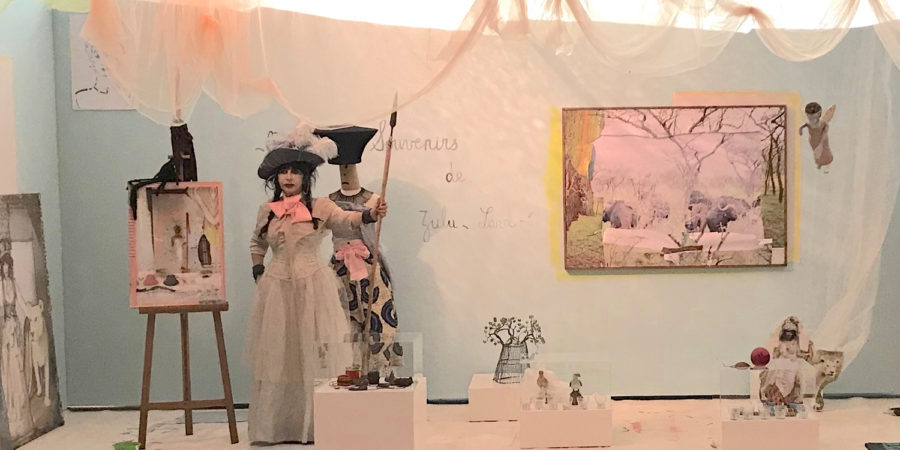The following is a previously unpublished interview with Colette Lumiere, conducted in 2017 by Nico Jacobsen. However, after reading it, I felt it important to share. So, in cooperation with Colette Lumiere and Nico Jacobsen, I am honored to be able to present it to you here. And to celebrate the new year, at the end of this post, I catch up with the artist to chat about what’s on her mind for 2020.
Interview: Colette Lumiere
By Nico Jacobsen
Part 1: Interview – 2017 & 2018
Part 2: Update – January 2020
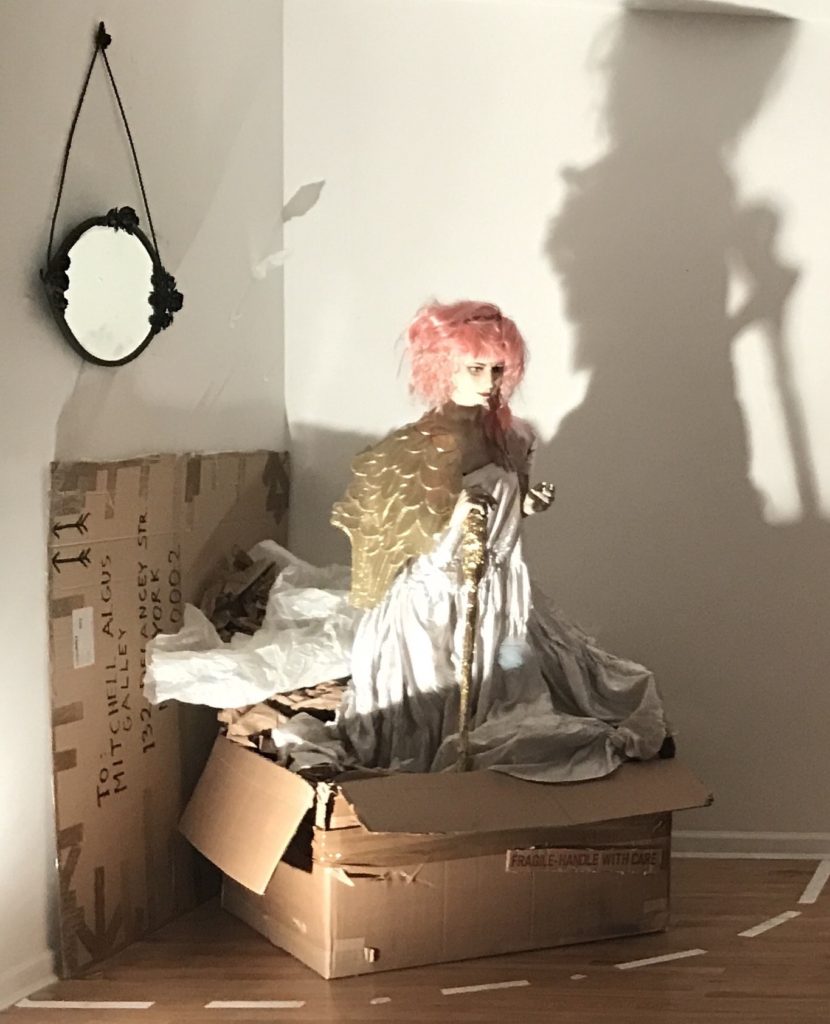
Colette Lumiere is not a person I can easily describe, nor is she a person I feel truly capable — or, rather, worthy — of introducing, but I will try. Although she is not originally from New York and no longer lives in New York, she is as much a part of this city’s storied history as any other artist that may spring to mind. Throughout the decades, she has acted as both the protagonist and an invisible hand, imbuing a wide range of artistic movements with her singular approach to creation. While many artists make pieces, she instead builds worlds, as well as characters to inhabit them, and they are absolutely intoxicating. Such was the case when I entered the Mitchell Algus gallery last fall, where her Artforum “Best of 2017” nominated show, Love in the Attic…Mermaid in the Closet, was shown. It doesn’t take long after immersion in Colette’s world that you realize the true magnitude of her influence — its weight positively forcing me to speak to her about her dizzying journey through the art world.
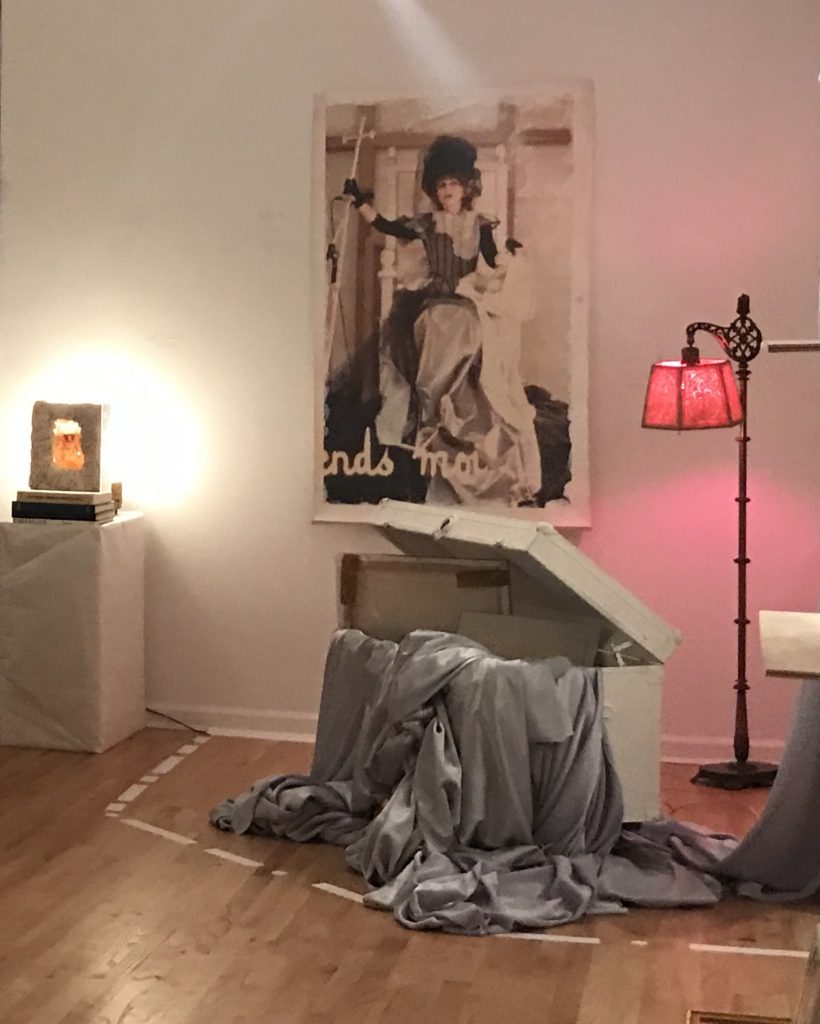
N: First of all, please let us know what a day in the life of Colette is like in 2017?
C: Ah! Wouldn’t you like to know?! You mean Lumiere! Lumiere does not have a routine. Posted on her door, a sign reads, “Laboratoirelumiere/Do Not Disturb! Experiment in Progress.” When she is working on an art project or conducting one of her art experiments, time goes by unnoticed. She is, then, unstoppable. Do not stand in her way!
Living in Berlin, at “The Lowen Palais” in a section named Gruenewald, with woods and lakes all around me, has played a role in my new reality. Hogs, boars, foxes, and other wildlife coexist in this environment, even though not often visible. My nocturnal nature has gotten accustomed to longer days, and walks in nature have become a daily ritual. Less nights are spent partying and nightclubbing. I do make appearances at the art openings of friends. Other evenings, I enjoy my solitude, or sharing dinner with other kindred spirits. It is still reassuring that I’m just a couple of bus stops away from city life.
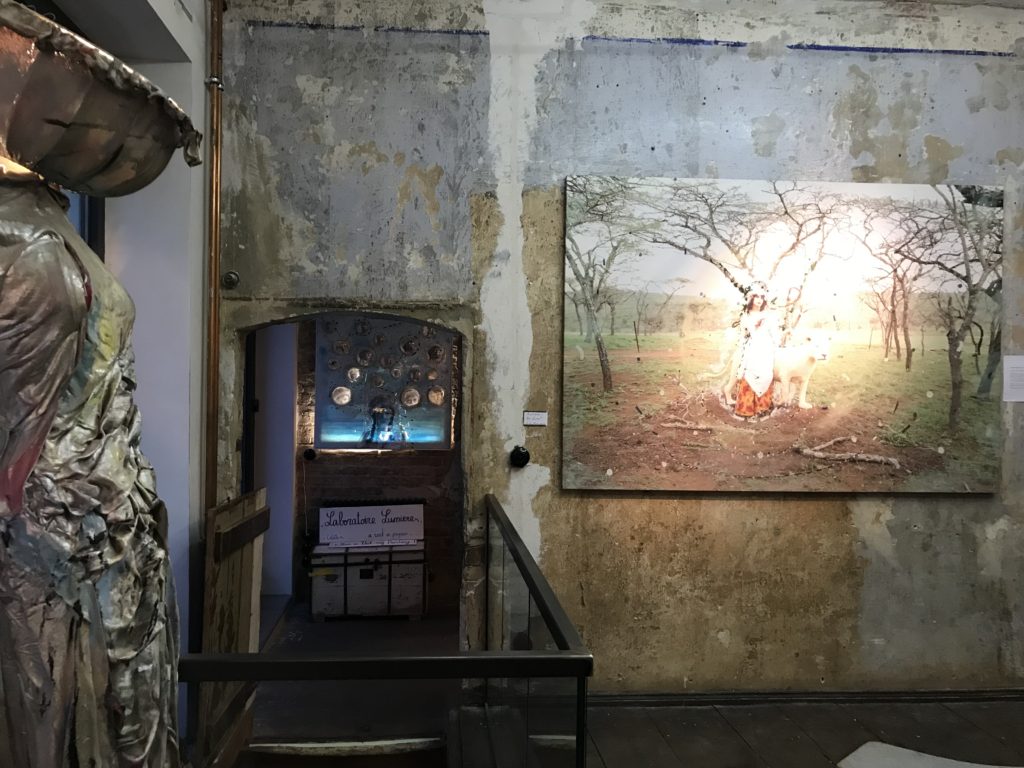
N: Your work has been questioning traditional gender roles since the ’70s — decades before they were the topic of regular coverage. Your way of empowering women through reinterpreting romanticized portrayals of them was atypical of the feminist approach at the time. When do you remember first finding such strength in traditional feminine signifiers? Do think there is any importance for us to not morph into a totally fluid blend of both sexes?
C: Well said! It began with fairy tales…then the silver screen. Literature, art history, the tarot, the Bible, my dreams. Powerful, rebellious, and brave women showed up everywhere, as if they were trying to tell me something. As far as the morphing of both sexes…I find the idea very intriguing; but I am not sure what I am ready for in this lifetime. Perhaps it is the way of the future? Or the afterlife? For now yin and yang works for me.
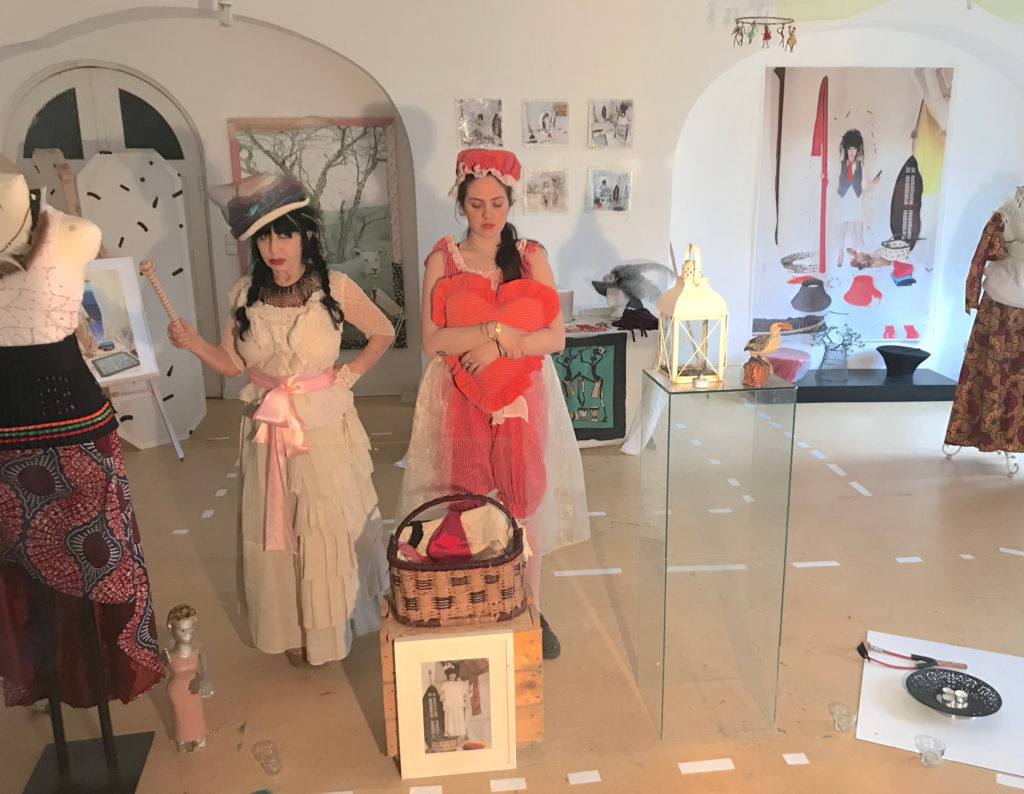
N: You have temporarily embodied numerous powerful subjects as props in your own pieces — these include Liberty Leading the People from the Delacroix painting, Mata Hari, Olympia, and even Joan of Arc. Did you take to any of those shells more than others? Were you ever sad to step out of the idea of one of them?
C: Okay, let me clarify. I named many of my early living tableaux after female heroines. Some of them you named. I suppose I saw an aspect of myself in all of the ones I selected. Once the work was completed, so was the experience. To elaborate, Arianne (in Delacroix’s ”Liberty Leading the People”) was my first private photo performance documented in a photo work.
But in 1978, I created my first ‘living persona’ as a response to obstructions I was facing in my life. I have had six living personas so far, including Colette, my birth name: Justine… Mata Hari… Countess Reichenbach… Olympia… and Lumiere. Each inspired by either life circumstances, a change of location, or a global event. The personas deviated from the bearer of the original name, but usually shared a common feature. Transitioning to a new living persona is a very organic process. It is like shedding a skin in order for the next transformation to occur. So there is no looking back.
I should add, that within each living persona, I continued to portray other female heroines in my photo works (occasionally a male).
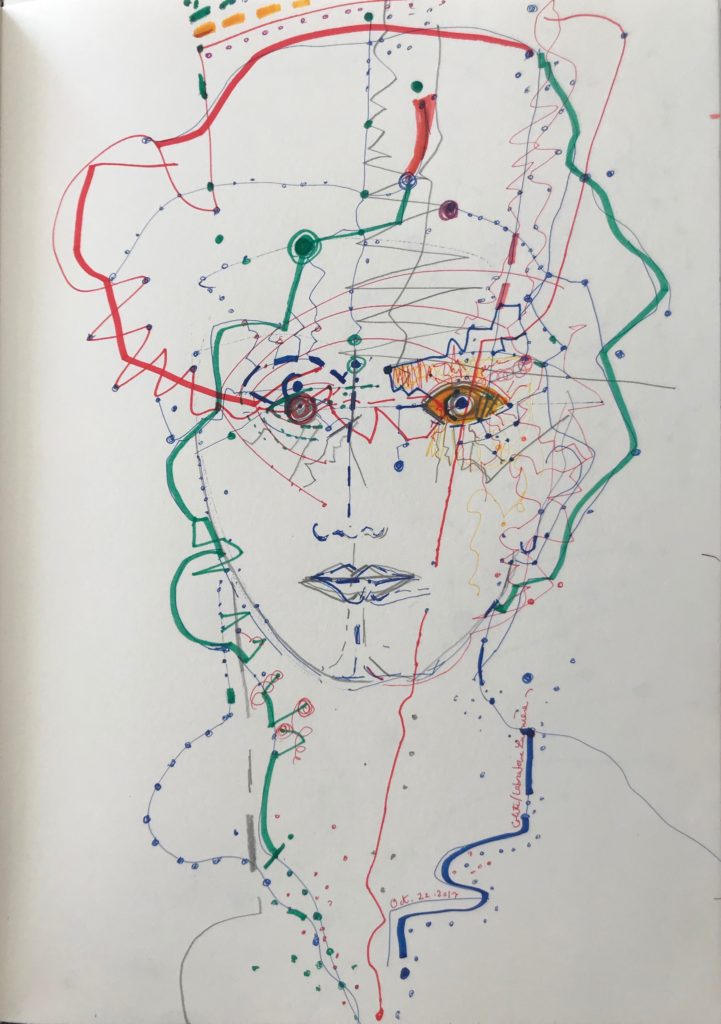
N: You staged a mock death of Colette in 1978, at the Whitney Museum, and then you called yourself Justine of the Colette is Dead Co. and sold off ephemera related to your past life. Did being a famous dead artist actually turn out to be more profitable than being a living one?
C: A famous dead artist usually turns out to more profitable than a living one. The problem is I was not really dead, ah! And, the series was way ahead of its time. Justine, a.k.a Colette, was a marketing genius. She posed as a recording star, a fashion and interior designer, a conceptualizer of Beautiful Dreamer products (Reverse Pop series, 78-83). This quote from an essay by Jeffrey Deitch explains the series well: “As Colette has become increasingly renowned in art circles, she watched her ideas filter into the products of designers, decorators, and others in the commercial world. This prompted Colette to begin using the commercial world as her medium. In her 1978 performance, The Last Stitch, she declared herself dead, arranging to be born again, as Justine, the executor of the late artist’s estate. She cleverly manages her inheritance and, like Picasso’s heirs, puts parts of the legacy into commercial ventures, e.g. The Beautiful Dreamer, or the Deadly Feminine line at Fiorucci, or the Beautiful Dreamer Bed in the Sakowitz Christmas catalogue.” (Colette Monograph, published by Politi, 1981)
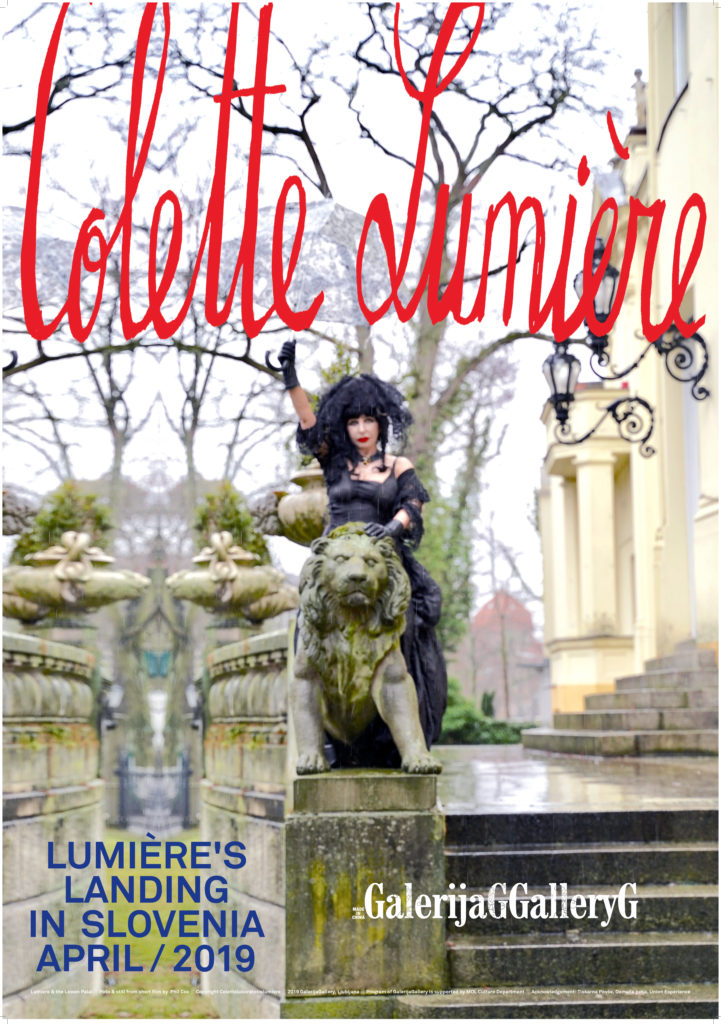
N: You took part in the 1975 exhibition at the Rizzoli book store entitled Fashion as Fantasy. This was 4 years before you designed your Deadly Feminine line for the Fiorucci store in New York. Do you think fantasy still has a role in commercial fashion, or would you say people dress and design less from their mind and more from examples in the current era?
C: Oh boy, Nico. You sure know how to cram a lot of questions in one. I have to fill in four busy, productive years in a few words!
Fashion as Fantasy at Rizolli’s book store on 5th Avenue was the first show I recall that included well-known artists, photographers, and fashion designers. Very unusual for that time. I was a young, emerging artist. I posed as “Ragdoll” momentarily in the windows of the store, wearing an old orthopedic corset I purchased on Canal Street; I often wore them over my garments. In the store was also displayed one of my large-scale light box sculptures, a perforated, bigger-than-life photo of myself nude in the midst of a fabric, bed-like frame — 8 feet high by 4 feet and 20 inches deep. A small version of this series, Bed Series 1, was included in the show at the Mitchell Algus Gallery.
Before I was well known for sleeping in my environments, I began receiving attention for painting the streets. The street works evolved into window works, a perfect blending of both. In 1978, Emilio Fiorucci commissioned me to create a window installation performance for his well-known boutique. In the store were also my art works… posters, postcards, and art ephemera.
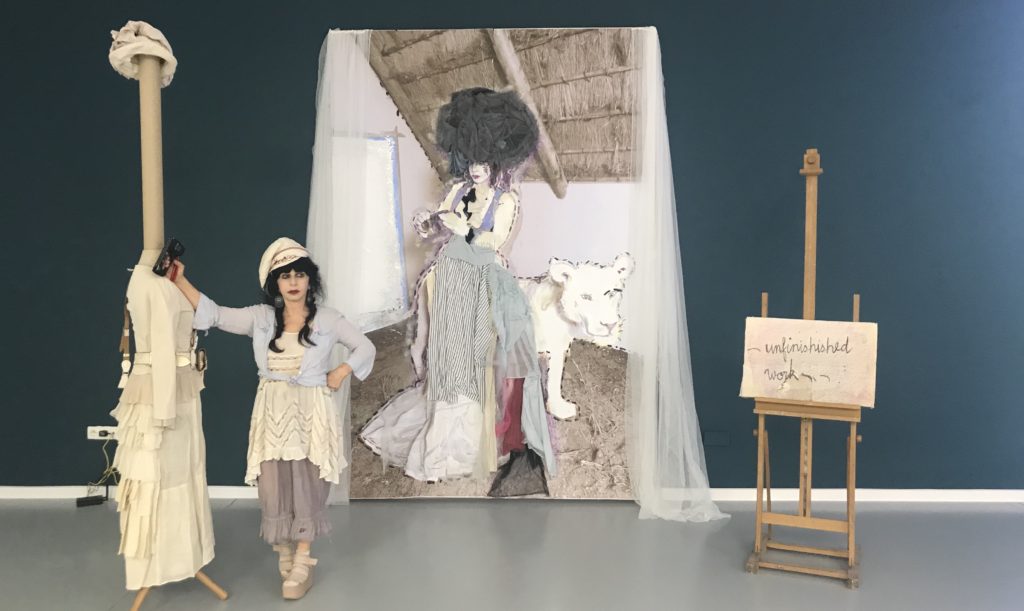
Soon after, my live appearance at Fiorucci, the staff at Fiorucci began to strike a pose in its windows, and the designers began creating products inspired by my “Victorian Punk” style. Recognizing my influence, Fiorucci then invited me to create a clothing line. The Deadly Feminine line (named after my trademark) was displayed in the shop’s windows in 1979, a year later.
I considered the line of clothing another art multiple in the “Colette is Dead” series; another art intervention in the “normal world.” On the windows I painted some of Justine’s favorite lines: “Great artists don’t kiss ass,” “I love my life, live my art, so fuck the critics.”
I do not keep up with the latest fashion fads, designers, etc. It is not often that I see something that excites me in the windows of most boutiques, even in Berlin. However, there are always some designers with fantasy, who manage to have a label and a venue.
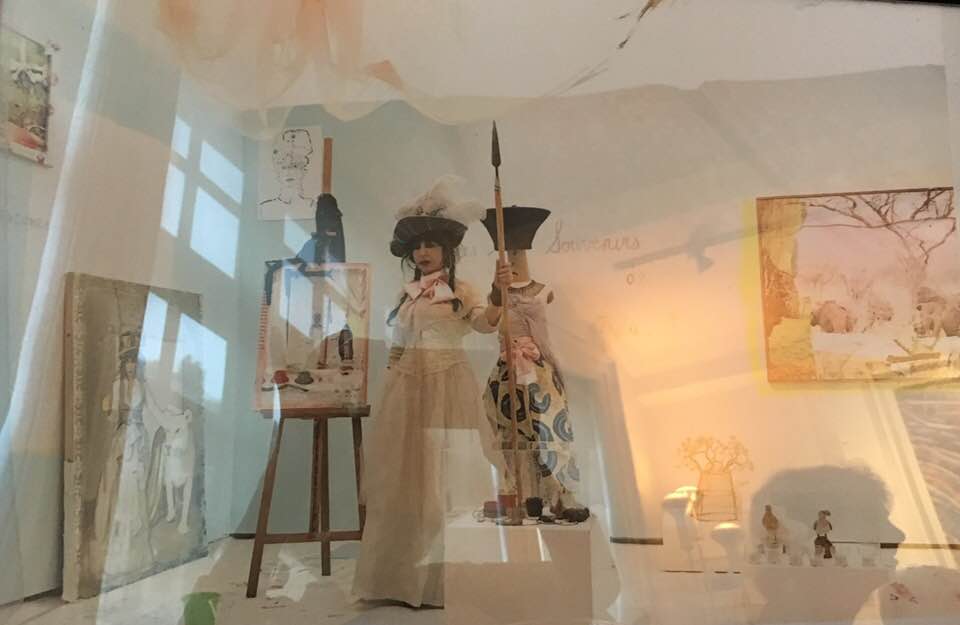
N: You were a regular attendee and performer at nearly all of New York’s most famous clubs such as Danceteria, Mudd Club and Club USA. Danceteria was known primarily for disco and house, Mudd Club for post punk and hip-hop, and Club USA for early rave, techno, and hardcore. Can you tell us a little about what you learned from moving through such diverse scenes? Did you prefer any one of them over the other? Do you have a favorite club moment?
C: I am going to have to write a book! Even after I became known and was exhibiting in major galleries and museums, I continued to use alternative spaces to present my art. Nightclubs became a favorite. It is known that I played a pivotal role in bringing art to the nightlife. My prime interest, however, was to circumvent the traditional art venues as well as to reach varied and multiple audiences. I also loved the fun and feeling of freedom that the scene offered (“Fuck Art…Let’s Dance,” was my motto and I coined these words).
However, my art interventions in mainstream venues were probably the cause of more imitation of my vision, misinterpretation of my work, and even what led to the current disappearing line between art and pop culture — contrary to my wish and intention. Like Einstein discovering the Atomic Bomb, I am afraid it is too late now. ah…
I have an endless list of favorite club moments during my time travels into the night life. For example, my funeral party at the Mudd Club, as well as the art-fashion show staged there to celebrate my “Deadly Feminine” line for Fiorucci in ’79; the opening of Danceteria in May 1980 with my “Fuck Art… Let’s Dance” installation – ( I lived with Rudolf, who ran the club); the Beautiful Dreamer benefit at Danceteria October, 1980; the Modern Bride installation tableau at Studio 54 in ’82; Justine joining La Rocka Modeling Agency, with a multi-media performance in 1982 at Armegeddon’s; jumping out of a cake for Johnny Rotten’s birthday in ’83 (also at Danceteria); the final Fashion Solution, at the Underground 1982; Art On Stage I at Danceteria in 1983; There’s A New Girl In Town at Fofi’s Nightclub in Berlin (Bringing Art to Berlin Clubs – introducing my conceptual service); Dial C for Scandal, first conceived in Munich at Bolido’s Nightclub (for the afterparty for my show, The Bavarian Adventure at the Dorsky Gallery in 1988) where the windows of the club were Colettesized with live models dressed in my designs (and inside, many more surprises!); Club USA, 1993; the after-opening parties at The Palladium in 1990, where my art had previously been on exhibit with the likes of Basquiat, Herring, Schnabel, and Clemente; The Original Living Doll organized by The Women of Power; the Ruins & Rise of the House of Olympia, at Club USA in 1994; the phenomenal multi-media event/art show I had at “The Church” in 1998, etc., etc., etc.
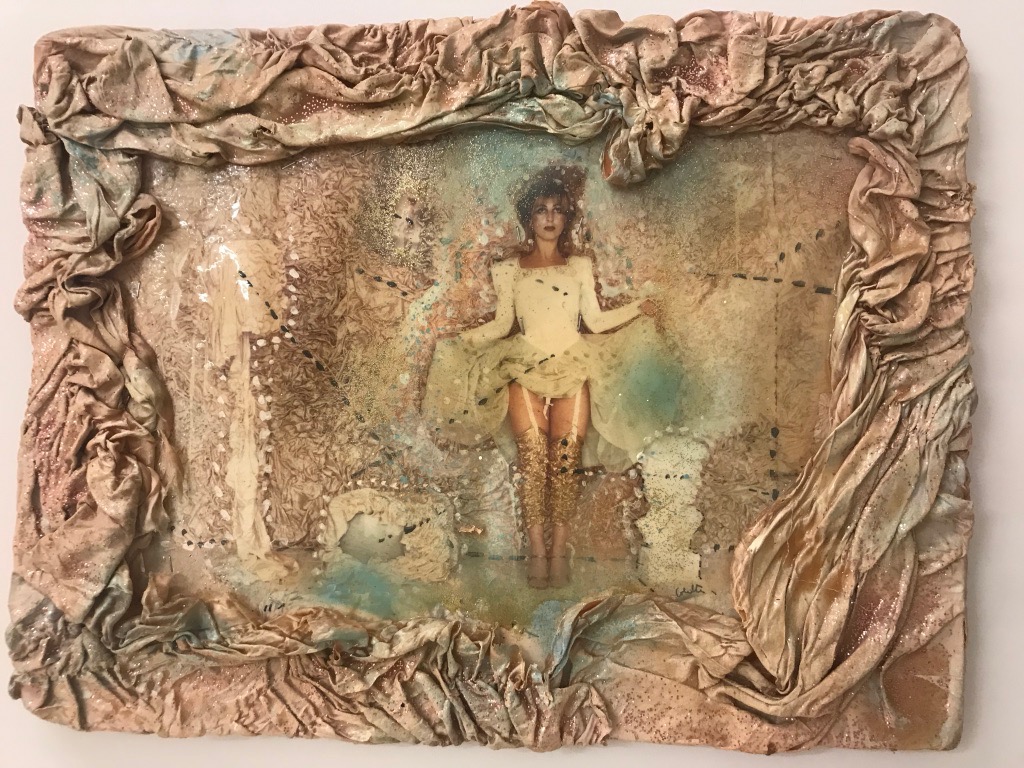
N: Speaking of the club scene, what is your favorite music?
C: I love the best of everything. Punk, new-wave, disco , hip-hop, rap, jazz, country, classical, and opera.
The last big art event I remember staging at a nightclub was at the Crow Bar in 2004 to celebrate the founding of the “C.I.A.” (the Colette Institute of Art – “Fight Terror with Glamour” was its motto). It was a wonderful installation with a great audience. Unfortunately, the quality of nightlife had already deteriorated. The minute my event ended, I fled and so did my friends as soon as the music changed.
I am glad that younger people wish to know more about that world. Richard Boch has written a wonderful book, The Mudd Club (I have some photos and pages in it). MoMA PS1 has now a show on Club 57. I wish they had not excluded individuals who shaped the scene at the Mudd Club, and other previous venues. Sometimes one has to wonder about the accuracy of history being recorded…but that is another story.
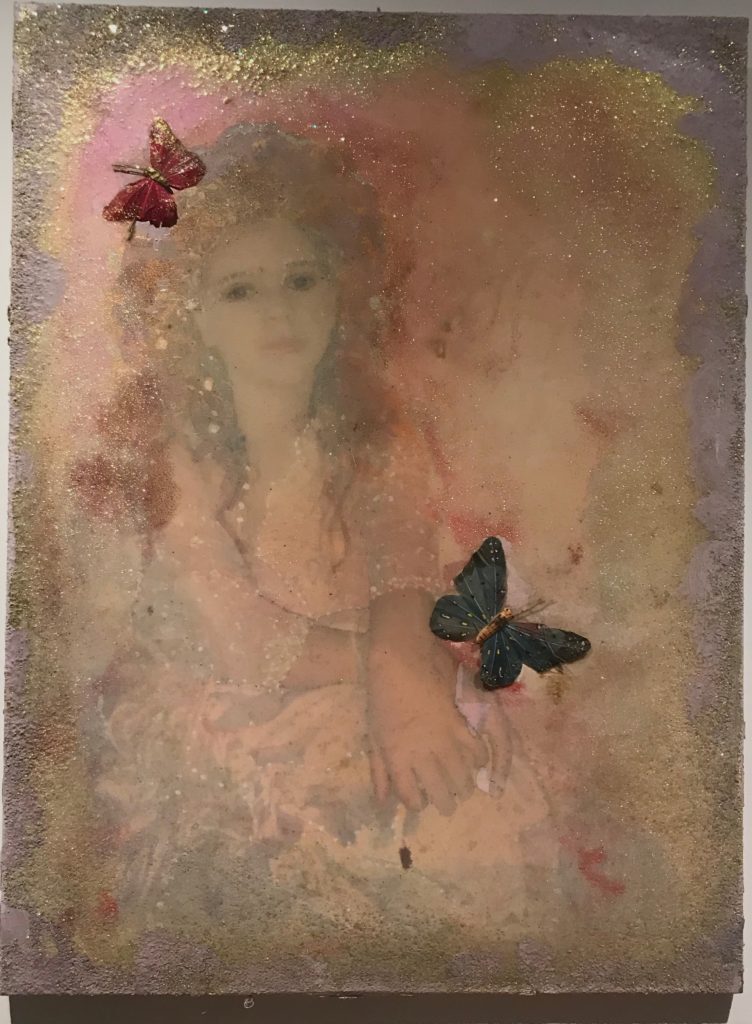
N: You stood out immediately for your embrace of the darkly lavish Victorian or Rococo style of dress and design — draping shimmering and deconstructed fabrics so densely they almost became like dripping stalagmites on your ceiling and off your body. There has been a serious renaissance of this style recently in New York, with brands like Women’s History Museum, Lou Dallas and Gauntlet Cheng employing a similar aesthetic and sharing a lot of the same ideals present in your work. Are you aware of this movement? Do you see any connection between the 1970s and the 2010s that might have made the Victorian Punk style resurface?
C: You said it beautifully . No, I am not aware of the brands you mentioned, but I am not surprised. It is impossible for me not to notice the connection to the past you are referring to — whenever I flip through a fashion magazine at the hair salon, or when I am on line at the supermarket browsing magazines. “Victorian Punk” is a term I often hear, without reference. I sense there is a wave of creative designers (probably the ones you mentioned) who feel a nostalgia for times gone, or simply crave more fantasy and freedom of expression, might be looking to the past decades for inspiration? Whether they are aware of my work or not, my aesthetic does seem to be written all over their creations. I find that to be a good thing!
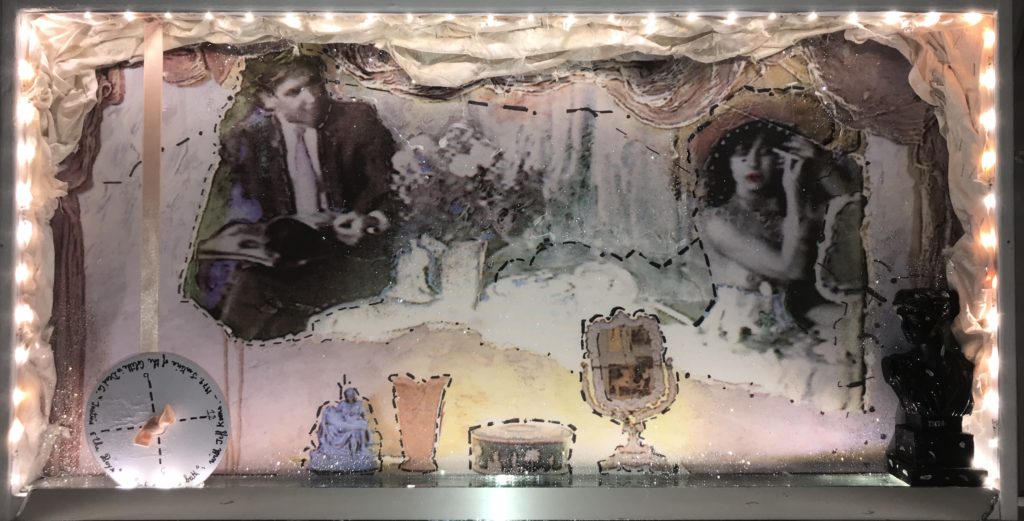
N: And finally, anything you wish to report?
C: You have already mentioned my solo show Love in the Attic… Mermaid in the Closet at Mitchell Algus, which was an on-site installation that capsuled moments of my history right up to the present in one work. It made reference to the most recent monumental installation at MoMA PS1, while it contained within other precious gems (artworks) from the past.
This January, I was invited to Stockholm for the unveiling of my new body of works, Les Tresors de L’Afrique, conceived in Zululand, South Africa in November, 2016, and organized by Johan Falkman for Thanda Art Projects. All my artworks auctioned during the gala reception at the Stockholm Auktionverk for the Star for Life Foundation were sold on the spot!
In May, I opened two solo shows in Berlin, Berlin Diaries at Seven Star Gallery – Berlin Mitte, and an on site installation/exhbition,
Berlin Night Drawings at the Susanne Albrecht Gallery, Charlottenburg… what I consider the equivalent to New York’s Uptown and Downtown.
During the Berlin exhibitions, I flew to Paris to Perform one of my “Lumiere Apparitions,” From Liberte to Lumiere /Fight Terror with Glamor,
participating in the Jeunes Creations Art Festival, held at L’École des Beaux-Arts.
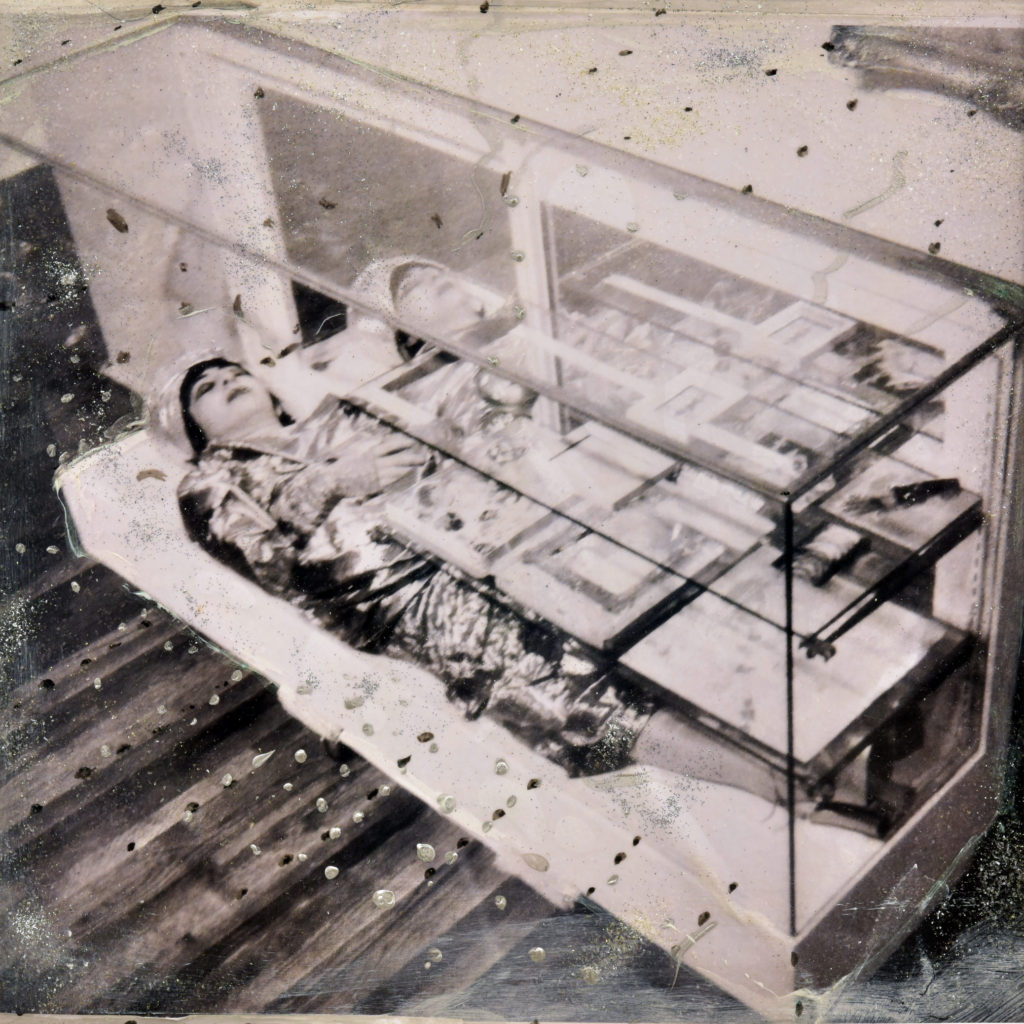

A Recent Chat With Colette…What Does 2020 Have In Store For Her?
By Terri Maxfield Lipp
As I was preparing this post, I chatted with Colette about where she’s at now and what kinds of things she has planned for the future. Here is a bit of that conversation:
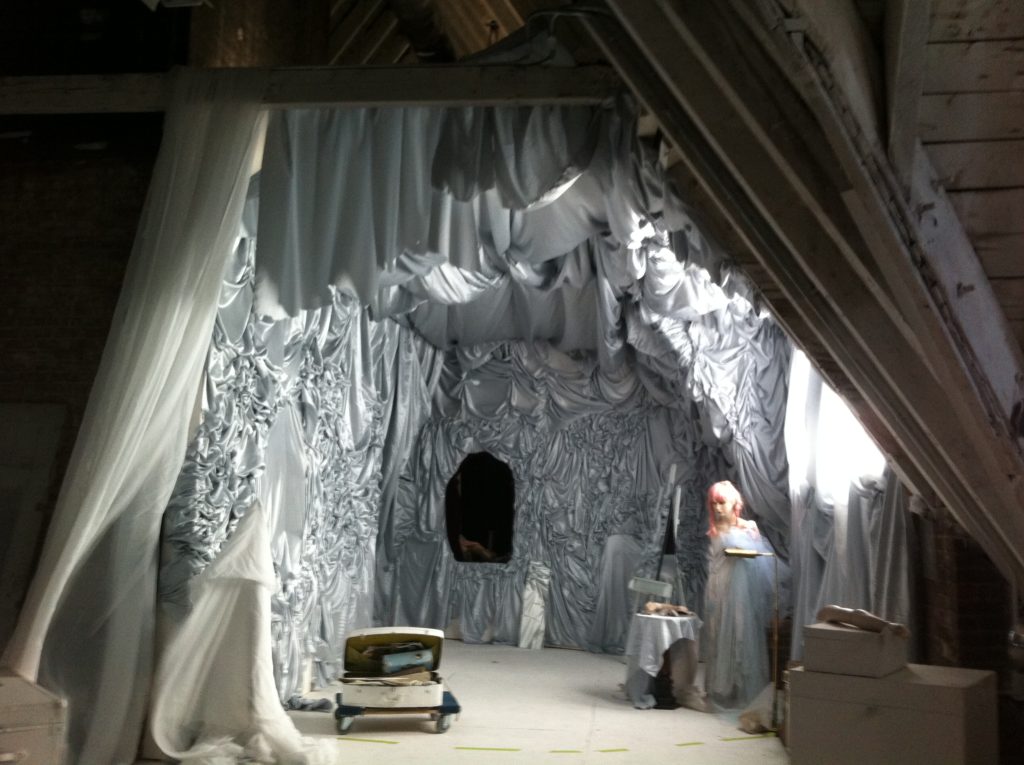
T: So how’s it going for you in Berlin? You’ve been there a while now, are you still finding it the place to be?
C: I came to stay in Berlin for one year, and I’m still here!
I am and have been an active participant of the art scene here, and I go back and forth to my home NYC to exhibit . But, even though many Berliners acknowledge my contributions in this town, I still feel a bit in artistic exile.
Living in the Lowen Palais in Berlin has offered me some distance from NYC . It agrees with my impatient creative nature, which cannot wait for “the approval of the establishment” to create. In the past, Alanna Heiss (PS1 Founder) and others, as well as myself, have written on how my work has managed to circumvent the art world. Here is a quote from a previous interview for Bomb Magazine, “My art began in the streets and it began anonymously. Even though it soon found its ways to galleries and museums, I continued to explore unorthodox and alternative spaces. Art does not have to be displayed in a museum or major gallery to be significant, to speak to people and influence art and culture.”
I can describe my stay here at the beautiful Lowen Palais as “living in an alternative space.” Another unorthodox art space, like the streets, the clubs, the store windows…it is, after all, primarily a residency for younger artists.
However, it has been a perfect place for the “Laboratoire Lumiere’s” experimentations, and I do incorporate experimentation in my work. I am a true Process Artist/On-site Installation Maker .
T: What are your dreams and plans for 2020? What do you envision for yourself in this upcoming year?
C: I hope to share my vision and creative accomplishments on a more international level and in more established venues, through collaborations and other connected ways of working. For example, I completed the series Lumiere in Zulu Land and exhibited in The Eye Never Sleeps Festival in Poland where it had a great audience and public attention, but I have not exhibited that project here in Berlin, or the States. This is one exhibition which I would like to see in a prestigious gallery in Germany, or a museum in the States, something like the MoCa or the Brooklyn Museum.
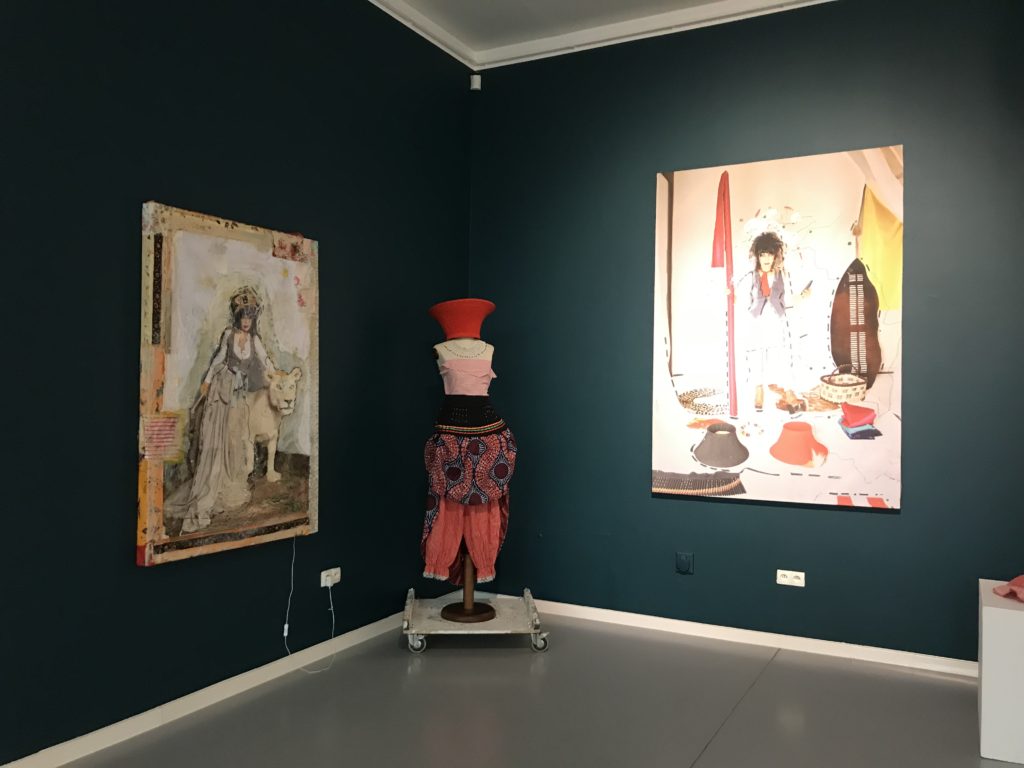
T: I’ve heard talk of an overdue “Retrospective,” the Colette “coffee table book,” and the preservation of your Archive. Can you give us some insight on any of that?
C: Ah , for years I continue to be asked “When is someone going to give this ‘living legend’ a Retrospective?” Some even post about it on Facebook and Instagram! Ha ha!
Well I am delighted to share with you that I have arrived at a great resolution, so we can now put all this to rest! As the “a bit too trendy for my taste” expression says, “Why not leave it up to the Universe to take care of it?” When it does happen, it will be in the best venues, more extensive (it will cover a longer history), and the book…yes THE BOOK! It will be a lot bigger!
This last spring, a fashion venue in Berlin had planned to exhibit The Return of Justine and the Victorian Punks in their trendy boutique in Berlin, with an exhibition of my works, a “Colettesized” window, and presentation of a new fashion line accompanied by a coffee table book, The Colette Look, which was to include my fashion interventions. Most timely, since so many current exhibitions of artists with unique personas include the artists wardrobe as well as their art. For example Stephen Varble’s show at the Leslie-Lohman Museum in NYC, in 2018. Varble was a marginal artist, who also dressed up in the late 70’s and early 80’s (there was a reference to my work in the show with a photo of myself as “Ragdoll” at Rizolli, 1975) Since my career, my art and influence covers a much wider range of ideas and has longevity, I am confident that greater recognition and exposure are inevitable. The recent Frieda Kahlo exhibition at the Brooklyn museum in 2019 is actually a better example. Naturally, both artists are long dead! aha.
Unfortunately the fashion/art project I mentioned which was to be held in the fashion outlet in Berlin did not manifest. The venue did not come through with their commitment, and I had no choice but to withdraw. I have faith that a better situation will arise for this concept, whether in an art museum or fashion venue like FIT, in NYC. So many of my friends were too young to experience this special time and wish to know more about it.
It is comforting that my history keeps surfacing. Just the other day, you forwarded me a recent article in Italian Elle about my collaborations with Fiorucci that I had no idea was even written. According to Google Translate, the headline was “Not just fashion. The story of Elio Fiorucci and his meeting with Colette Justine which made him even more iconic. Do you know Madonna and Lady Gaga? Here’s who inspired them.”
Simultaneously, I was browsing through the book recently published by MoMa about the history of PS1. I recollected all my involvement with this institution since its beginning. I am well aware that it is impossible to include all that occurred during four decades in this volume, particularly if artists were part of a large group show, no matter how elaborate the work might have been. I am happy that this book exists and of my inclusion. However, many of the installations I created and exhibitions I participated in, particularly in its beginnings were not included. For example, my black satin tomb in 1978; David’s Wrath, where I posed as Marat, created for the opening of the Rooms in 1976; and there was no mention of the most recent, a monumental environment recreated in the attic, There’s A Mermaid in the Attic, which remained months after the rest of the works in the other 40 shows were dismantled. My book would include these no longer existing environments, and my story from my personal perspective as the artist creating them.
Besides exhibiting in art institutions, I am interested in collaborations outside of the art realm, such as being commissioned to create public interiors like The Bedroom, the gesampkunstwerk in which I Colettesized an entire floor of the HPGRP fashion/art building in Tokyo in 2005. Lecturing about my art and life around the world is also on my list.
My wish for 2020: may my ideas continue to manifest and inspire, and my history continue to unfold in the best way possible.
T: Oh, and McArthur Award might help?
C: Most certainly! I welcome any divine interventions!
Selected Activity 2019:
March, 2019
Multi-media installation-performance
“The Rehearsal” (including works in progress from Zulu Land )
Lowen Palais, Koenigsallee 30-32, Berlin, Germany
June – August, 2019
“Masterpieces”
Mitchell Algus Gallery (group show)
132 Delancey St, New York, NY, United States
July – August, 2019
“Lumiere in Zulu Land II”
Large scale exhibition for “The Eye Never Sleeps Festival”
BWA – Municipal Art Gallery of Bydgoszcz, Gdańska 20, Bydgoszcz, Poland
September, 2019
“Laboratoire Lumiere in Berlin”
Vivian Horan Fine Art, 40 East 62nd Street, New York, NY, United States
November, 2019
“Clean Up Time”
Solo exhibition
Stiftung Starke Foundation, Koenigsallee 30, Berlin, Germany
April – November, 2019
“Lumiere and the Lowen Palais”
Short film directed by Phil Cox (director of “They Say I’m Different,” documentary about Colette’s longtime friend, rock legend Betty Davis)
Presented:
• April – Galerijagallery, Trg prekomorskih brigad 1, Ljubljana, Slovenia
• June- July – Palace Ostromeko, Bydgoska 9, Ostromecko, Poland
• September – Vivian Horan Fine Art, 40 East 62nd Street, New York, NY, United States
• November – Stiftung Starke Foundation, Koenigsallee 30, Berlin, Germany
November 2019 – February 2020
“Self Portrait” – group show curated by Salon Hansa
Lachenmann Galerie, Hinter der Schönen Aussicht 9, Frankfurt, Germany
For more information about Colette Lumiere:
http://colettetheartist.strikingly.com/
http://www.colettetheartist.com/
http://www.artnet.com/awc/colette.html
*
